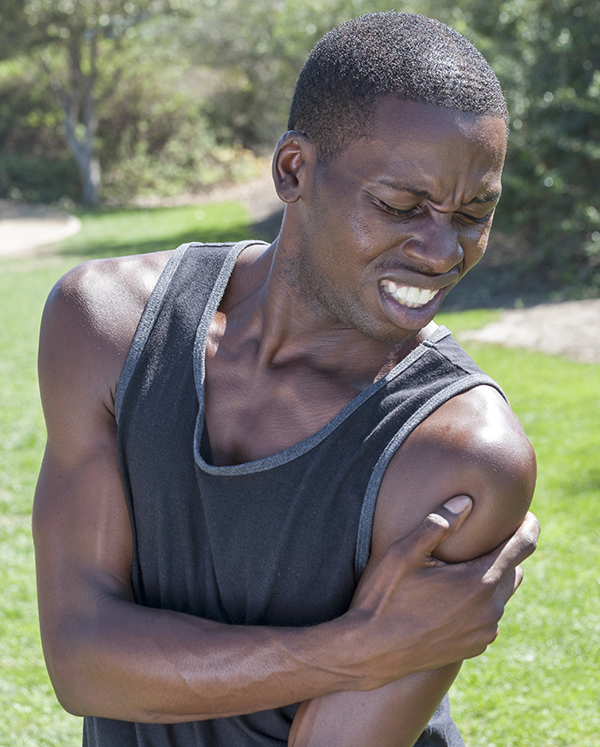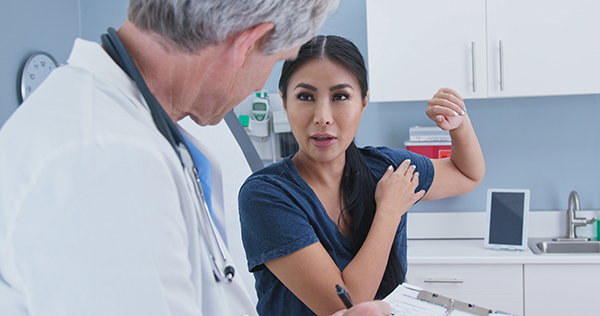January 14th, 2020

If you’re constantly experiencing a catching or locking sensation in your shoulder when you lift heavy objects, you may have a labral tear in your shoulder. What is a labral tear? How do you know if this is what’s causing your shoulder pain? If you do have a labral tear, how is it treated? Keep reading to get the answers to these questions and more.
What Is a Labral Tear of the Shoulder?
A shoulder labral tear occurs when the labrum—a piece of cartilage lining the shoulder joint—is torn. This injury most frequently occurs in athletes but can occur in any individual who experiences trauma to the shoulder.
There are two common types of labral tears. The first is called a SLAP tear, short for superior labrum from anterior to posterior. SLAP tears occur at the front of the upper arm, where the tendon from your bicep connects to your shoulder. Another common type of tear is a Bankart tear. These commonly occur when a shoulder is dislocated.
Causes of Labral Tears of the Shoulder
Labral tears are most frequently seen in conjunction with other shoulder injuries, such as torn bicep tendons, shoulder dislocations, or rotator cuff injuries. Other causes of labral tears may include falling on an outstretched arm, a sudden tugging or yanking on the arm, sustaining a violent blow while reaching overhead, or receiving a direct hit to the shoulder.
These types of injuries are most commonly seen during high-impact sports. However, they can also be sustained in a number of other situations, including car accidents, workplace injuries, and even simple slip-and-fall accidents.
Additionally, labral tears can occur in older patients as a result of the simple wearing down of the labrum over time. Gradual fraying or tearing of the labrum can be a normal part of the aging process and is handled quite differently from acute tears in younger patients. If you believe your labral tear is a result of age rather than injury, be sure to discuss your options with your doctor.

Symptoms of a Labral Tear of the Shoulder
Of course, it’s possible to experience trauma to the shoulder, along with some residual pain, without having sustained a labral tear. However, if you’re experiencing symptoms and they aren’t improving over time, you may want to see a shoulder orthopedic surgeon. These symptoms include:
- Shoulder pain, accompanied by a catching, grinding, or popping sensation
- Instability in the shoulder joint
- Decreased range of motion
- Loss of strength in the joint
- Pain at night or during normal daily activities
If you do contact a shoulder specialist regarding these symptoms, the orthopedic doctor will evaluate the joint stability, pain level, and range of motion in the shoulder. The physician may also order X-rays or an MRI. The most reliable way to diagnose a labral tear is through shoulder arthroscopy, a less invasive surgical procedure that allows the skilled physician to inspect, diagnose, and often repair the problem right inside the joint.
Treating a Labral Tear of the Shoulder
In most cases, labral tears are treated with over-the-counter medications to reduce pain and swelling, plenty of rest, and physical therapy to rebuild strength and mobility in the joint. However, if your injury is severe enough, you may require surgery. The majority of surgeries for labral tears are minimally invasive and recovery is quick. For example, a torn labrum may be corrected with a Bankart Repair surgery. An arthroscopic procedure may be performed to repair a tear of the biceps tendon at the point where it connects to the labrum, SLAP Repair.
If you’ve sustained a labral tear, speak to a specialist in shoulder orthopedics in Atlanta. The doctors at OrthoAtlanta are highly experienced in handling labral tears and other injuries, so call to schedule an appointment today.
Back






